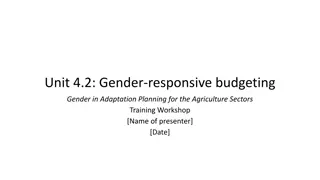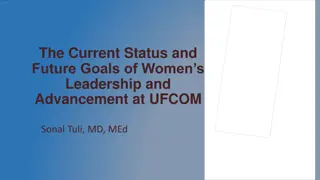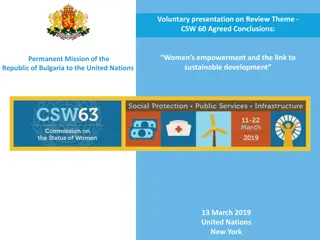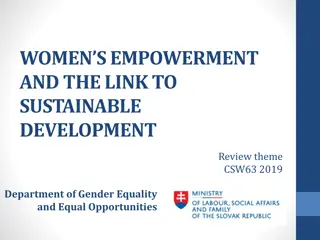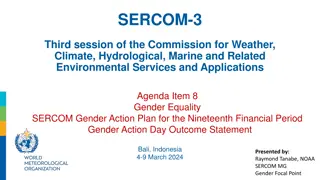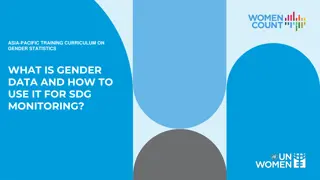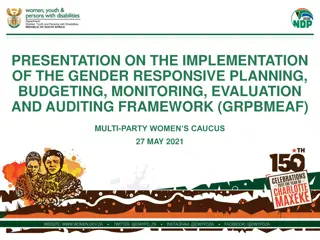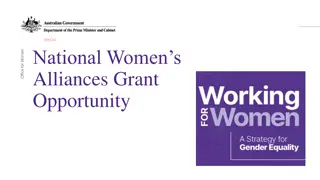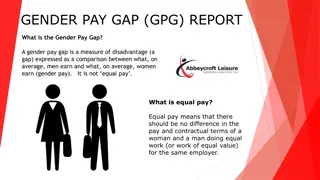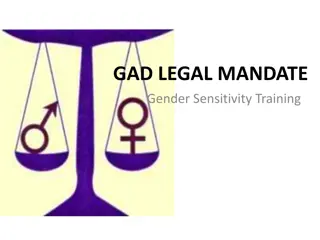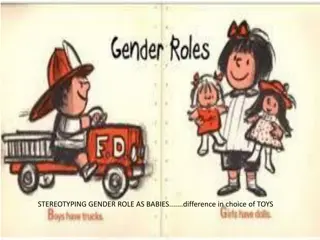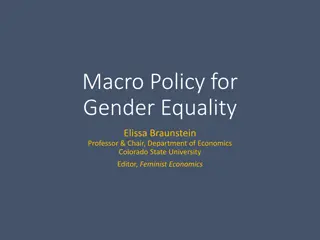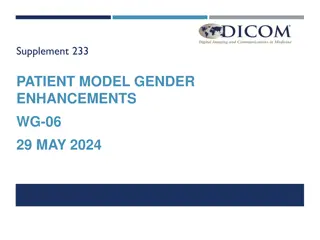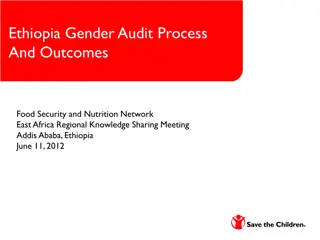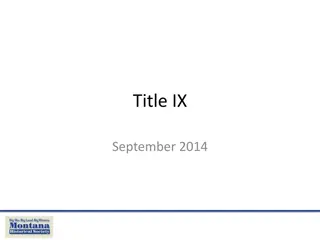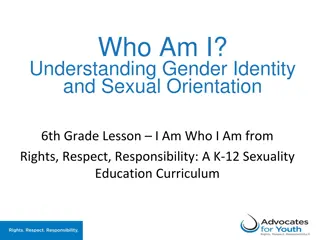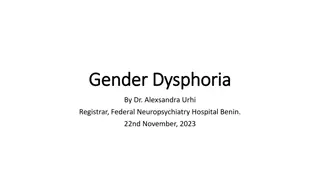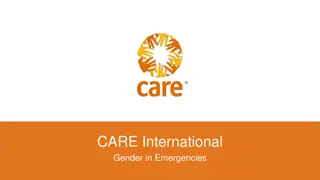Women, Medicine, and Life Cycle: Exploring Gender and Health Through History
Explore the intersecting realms of women, medicine, and life cycle from historical perspectives to present-day relevance. Delve into gender dynamics in healthcare, women's agency, the one-sex/two-sex model evolution, and the discourse on female bodies in medical practices. Uncover the impact of feminism, challenges faced by women in medicine, and the notion of agency amid power dynamics in healthcare.
Uploaded on Sep 19, 2024 | 0 Views
Download Presentation

Please find below an Image/Link to download the presentation.
The content on the website is provided AS IS for your information and personal use only. It may not be sold, licensed, or shared on other websites without obtaining consent from the author. Download presentation by click this link. If you encounter any issues during the download, it is possible that the publisher has removed the file from their server.
E N D
Presentation Transcript
Women, Medicine and Life Cycle Cradle to Grave Term 2, Lecture 4 (lecture 12)
Lecture Outline 1. Historiography Emergence of research area women and medicine/history of gender/patients view Feminism and health women s health movement 2. Sex difference (revisited quickly) 3. Specialists fields - gynaecology and psychiatry 4. Female diseases : puerperal insanity and hysteria 5. Women and agency 6. Women treating women female doctors 7. 20th-century women s health
Women, health and medicine Currently there is a huge interest in women s health and medicine. Second Wave Feminism from 1960s/70s onwards provided political rationale for research. Encouraged women to think about their health and bodies differently Our Bodies Ourselves: A Health Book by and for Women (1978). Interdisciplinary social history of medicine, sociology, gender and literary studies Joan Scott, Gender: A Useful Category of Historical Analysis , American Historical Review, 91, 1986, pp.1053-76. Critiques interchangeability of women and gender as terms Gender can and should be used to analyze social/cultural/political relations Interrogation of power and repression e.g. male power/female patient Women depicted as prone to ideologically driven interventions e.g. ideals of domesticity and patriarchal society in the 19th century and imperatives of state, nation and scientific motherhood 20thcentury.
Womens Bodies The female body particular interest to contemporaries and historians Women seen as being inherently more physical or corporeal than men uniquely beholden to their bodies (e.g. governed by need to reproduce etc., less mental capacity) Impact of male science on female bodies possession, exploration, penetration, understanding, control, repression, subjugation? But also issue of whether when women qualify in medicine they practice differently than men/women s agency.
The one-sex/two-sex model Thomas Laqueur, Making Sex: Body and Gender from the Greeks to Freud (1990). One-sex model: pre-Enlightenment women appear to have been considered inferior versions of men in medical terms i.e. two different forms of one essential sex. Women and men had same basic reproductive structures, tucked inside the body (vagina=penis, ovaries=testicles). Both male and female orgasm were essential for successful conception. Two-sex model - 18thcentury onwards the two sexes began to be seen as opposites. Only male orgasm seen as essential to conception and active sexuality a masculine trait. Normal women were not believed to have sexual desires (because unnecessary and unnatural) and thus female sexual activity aberrant in views of physicians, clergymen, novelists etc.
Oppression and Agency Ludmilla Jordanova, Sexual Visions: Images of Gender in Science and Medicine between the Eighteenth and Twentieth Centuries (1989) argues that power relations between men and women, are not clear cut or one- dimensional. Theory/rhetoric and practice not necessarily the same gap between what is said and what is practised. Women s agency important as carers, doctors and patients.
Victorian doctors Anne Digby, Women s Biological Straitjacket , in Mendus and Rendall (eds), Sexuality and Subordination: Interdisciplinary Studies of Gender in the Nineteenth Century (London and New York, 1989), pp.192-220. The relationship between women and medicine not just caused by Victorian patriarchal society by 1700 women were already depicted as frail and unstable, medically unique but inferior whose health was determined by her femininity . BUT These ideas gain resonance from mid-19thcentury because of: growing professional interest in diseases of women (emergence of specialisms of obstetrics, gynaecology, and psychiatry) adoption of more political stance by individual doctors who invested in ideas of gender difference (connection to female education, suffrage, etc). Women seen as important client group in competitive medical marketplace.
Obstetrics and Gynaecology Part of story of professionalisation and specialisation New hospitals for women e.g. Birmingham Women s Hospital, Elizabeth Garrett Anderson Hospital, alongside maternity hospitals and wards treating women s disorders. Diseases of women become a special category tied to both obstetrics and gynaecology. Increasingly depicted women s health as problematic and pathological and to a certain extent inescapable victim of weak female nature, body and mind, which endured throughout life cycle. Surgical interventions introduced e.g. for hysteria or unacceptable behaviour or pain or reproductive problems. Clitoridectomy extreme manifestation of dread of female sexuality, 1,000s of ovariotomies performed.
Surgical approaches Before the recent advances of gynaecology, women, sane and insane, had to suffer from ills, now known to be curable [ovarian or uterine] diseases we know are apt to entail nervous disorders, and we have seen that nervous disorders, when complicating disease of the sexual organs, are frequently cured when the diseased organs are removed . Robert Barnes, On the Correlations of the Sexual Functions and Mental Disorders of Women , British Gynaecological Journal, 6 (1890-91). Yet gynaecologists divided between conservative (reluctant to use surgical approaches) and radical .
Diseases of women Thomas Laycock one of many authors on subject from mid- 19thC onwards. He had special interest in hysteria and nervous disorders but other authors focused more on gynaecology and the difficulties of parturition/childbeari ng
Sex, Pathology and Psychiatry Relevance of prostitution - represented all that was pathological about female sexuality and became a public health problem (Contagious Diseases Acts 1860s) Female sexuality and women more generally psychiatrised ; unruly women were mentally unstable Sexual behaviour linked to diagnosis: Hysteria and female sexual arousal Mania typified by unfeminine/overtly sexual behaviour Nymphomania defined in late 19th century. Mental conditions overtly related to female instability and instability of reproductive organs
Women and psychiatry Women s relationship with psychiatry repression? control? behaviour? Institutions/growth of asylums in 19thcentury. Elaine Showalter in The Female Malady suggested the majority of patients were women. Recent work has suggested that gender played less of a role than suggested in psychiatric diagnosis and also looks increasing at masculinity and mental breakdown (see e.g. Akihito Suzuki, Mark Micale, Martin Stone, Digby and Andrews (eds)) Reassessment of the asylum refuge? respite care? temporary? Acknowledgement that doctors saw female vulnerability to mental breakdown rooted in wide set of social, economic and circumstantial factors not just female life cycle and weakness/biological predisposition.
Puerperal insanity First defined/labelled in 1820 by Robert Gooch. Accounted for increased admissions to asylums around 10% of female admissions and often more and many treated as private patients at home and occasionally in maternity hospitals. Contested between obstetricians and psychiatrists both claimed expertise to cure. Seen as likely to reoccur and related not only to female biology and strains of childbirth, but also to worries about motherhood, poverty, domestic problems (insanity of lactation particularly associated with poor nutrition of mother, exhaustion and having too many children in quick succession). Catch all diagnosis rich and poor (excessive luxury and poverty), young and old, first time mothers and those who had many children.
Puerperal insanity W.H. Bagg, after a photograph by H.W. Diamond, Puerperal Mania in Four Stages, from John Conolly, Case Studies from the Physiognomy of Insanity , The Medical Times and Gazette (1858) Robert Gooch, On some of the most important diseases peculiar to women (1831), p.54. During that long process, or rather succession of processes, in which the sexual organs of the human female are employed in forming; lodging; expelling, and lastly feeding the offspring, there is no time at which the mind may not become disordered; but there are two periods at which this is chiefly likely to occur, the one soon after delivery, when the body is sustaining the effects of labour, the other several months afterwards, when the body is sustaining the effects of nursing .
Hysteria The daughters disease ? A Victorian epidemic? Connections to social class? Did the working class get it? Social and medical causes Over-work?/over- education? A form of protest against patriarchy? Allowed women to assume the sick role /invalid? Rebellion? A rich visual archive
Womens agency? Culture of invalid could be utilised by women Birth control many of its advocates were women Women s move into medical practice as doctors, professional nurses, health visitors, etc. focus on women and children s medicine, often advocate for women Women direct household income, which for some meant exercised choice in who to employ as doctors. Some interventions beneficial e.g. B ham Women s Hospital treated many women with severe gynaecological problems, problems of multiple births etc. prolapsed womb, varicose veins, etc. Women also had real sufferings and complaints. Household medicine women as medical activists or day to day practitioners and carers.
Women doctors Only 25 in England and Wales 1881, 495 1911 impact out of all proportion to numbers Many were feminists Elizabeth Garrett Anderson and Sophia Jex-Blake Worked in obstetrics, paediatrics, public health, school medicine, birth control (in early C20th) and private practice with women. Small number set up hospitals. Also produced health advice literature for women.
Elizabeth Garrett Anderson and Sophia Jex-Blake
Medical Women Fashionably dressed female doctor claims greater surgical competence than a male practitioner Punch, 14 September 1872
Womens health in 20th century Health disadvantage - class, gender and ethnicity. Heavy burden (work/home), childbearing - double burden . Women tended to have less access to health care. Yet also responsible for care of family, especially children mothercraft, infant welfare, children s health, nutrition and hygiene. Blamed and responsibility for families ill health and their own alleged ignorance on health and reluctance e.g. to attend clinics. Seen as vulnerable to mental illness and depression continues into 20th century. See Lucinda Beier working class women s health, but also connected literature - birth control, adolescence, midwifery and maternity.
Interwar years Medical Research Council (MRC) 1924 Report on miners and families ill health but due to failure of mothers (poor home care, hygiene, cooking). 1935 Report on Maternal Morbidity in Scotland 57% antenatal deaths due to women not following advice and failing to attend clinics. 1933 Women s Health Inquiry Committee explored experiences of 1,250 working-class women. Found enormous amount of ill health amongst married women. Illness often hidden and took ill health for granted. Report recommended: higher wages, better social service provision for children, family allowances, improved maternal health services, subsidised housing, extension of NI for women, better education in home management, etc. MOsH more sympathetic to women s plight. Background of Depression and housing shortage feeding and clothing children remained main preoccupation of women.
2ndWW and NHS Dual burden continued for women domestic labour and war work. Continuity - Women s role still regarded as wife and mother: William Beveridge housewives as mothers have vital work to do in ensuring the adequate continuance of the British race Rationing improved diet in latter years of war led to improved health, women s wages often improved SofL of family. 1945 Family Allowances introduced end of long campaign. Women s access to health care improves with introduction of NHS but still inequalities based on gender, class, locale and ethnicity.
Feminist strategies 1970s onwards women s health had higher profile inspired by women s movement (influence of US) e.g. refuges for women suffering domestic violence Urged women to learn more about their bodies and exercise more control over their health Well Women Clinics (WWCs). Holistic approach, but also checked for female cancers, reproductive health matters. Advice to women Our Bodies, Ourselves (1973) Much of women s time though still dedicated to looking after others women outlive men, but tend to be more unhealthy, WHY? Related to more contact with medical professionals, but also lingering assumptions about women s health and capabilities: weaker sex (more mental health problems) and women more likely to express stress through illness. Continuing impact of double burden ?
















